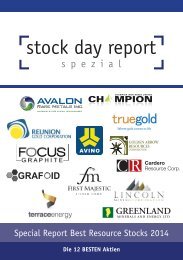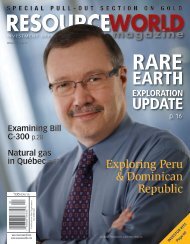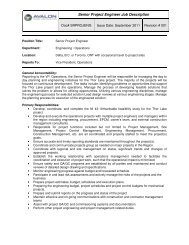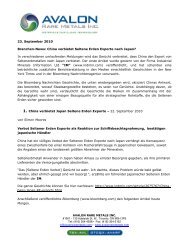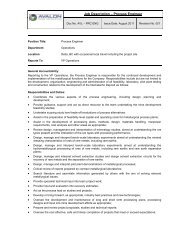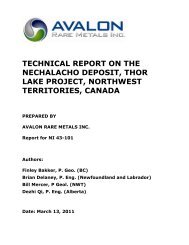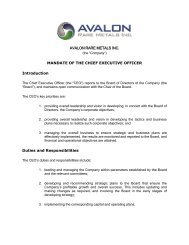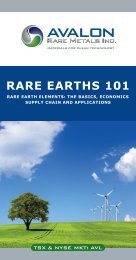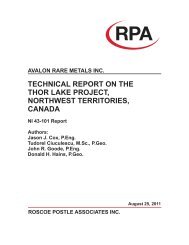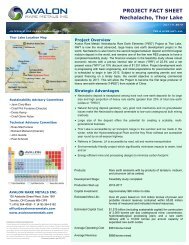Earths - Avalon Rare Metals
Earths - Avalon Rare Metals
Earths - Avalon Rare Metals
Create successful ePaper yourself
Turn your PDF publications into a flip-book with our unique Google optimized e-Paper software.
THE RACE FOR RARE<br />
e<br />
<strong>Rare</strong> earths are where you find them, and<br />
for <strong>Avalon</strong> <strong>Rare</strong> <strong>Metals</strong> that has turned<br />
out to be near Great Slave Lake in the<br />
Northwest Territories. These cabins on the<br />
company’s development site make for an<br />
iconic Canadian outpost.<br />
22 L’ACTUALITÉ CHIMIQUE CANADIENNE FÉVRIER 2012
BUSINESS | THIS TEXT CHANGES EACH ISSUE<br />
arths<br />
By Tim Lougheed<br />
Toronto’s <strong>Avalon</strong> <strong>Rare</strong> <strong>Metals</strong> has joined the global<br />
race to extract rare earth chemicals - key elements<br />
in many energy -generating green technologies.<br />
FEBRUARY 2012 CANADIAN CHEMICAL NEWS 23
H<br />
umanity’s longstanding love affair with gold may<br />
not have waned, but we are being wooed by some<br />
serious rivals in the periodic table. They are the<br />
rare earths, which are actually metals and not<br />
all that rare. These 17 elements are appearing in<br />
more and more of our high technology hardware, particularly<br />
the latest generation of green energy-generating<br />
technology. And with more than 95 per cent of the world’s<br />
rare earth production taking place within China, which has<br />
announced its intention to reserve that supply for its own<br />
growing use, the hunt is on to diversify the world market for<br />
these hot commodities.<br />
Such dramatic attention to rare earths is comparatively<br />
recent. They have often been regarded by prospectors as little<br />
more than a nuisance, comparatively useless materials that<br />
interfere with the refining of tantalum or niobium, the kinds<br />
of metals that really make money. In fact, until the 1980s the<br />
world’s largest source of rare earths was a mine in California’s<br />
Mojave Desert, which was shut down as demand tapered off.<br />
By 2010, however, Colorado Congressman Mike Coffman<br />
had introduced American legislation that would brand<br />
rare earths as economically strategic. “Our nation must act<br />
to protect our security interests with regard to rare earth<br />
elements,” Coffman said last year. “China is neither an ally<br />
of the United States nor is it a reliable trade partner when<br />
it comes to these strategic metals.” Dubbed RESTART,<br />
for <strong>Rare</strong> <strong>Earths</strong> Supply-Chain Technology and Resources<br />
Transformation Act, the proposal would promote the development<br />
of all relevant exploration, mining and processing<br />
capacity. The move parallels the revival of output from the<br />
Mojave Desert mine, which is expected to ramp up sharply<br />
in the next few years. Meanwhile, companies are scouring<br />
obscure corners of the globe elsewhere to investigate other<br />
sources of rare earths.<br />
One of the most promising of those sites is near Great Slave<br />
Lake in Canada’s Northwest Territories. Known formally as<br />
the Nechalacho <strong>Rare</strong> Earth Elements Deposit, it is located<br />
at Thor Lake, about 200 kilometres east of Yellowknife. The<br />
site was initially surveyed in the 1930s, when all that was in<br />
evidence was a large body of granite and gabbro, a form of<br />
igneous rock comparable to basalt. By the 1970s, aerial surveys<br />
with a gamma ray spectrometer showed high radiometric<br />
values raised the possibility of uranium. The readings were<br />
actually caused by thorium, which turned out to be affiliated<br />
with a substantial collection of rare earths.<br />
That survey and the ensuing discovery was made by<br />
Highwood Resources, a predecessor to Vancouver-based<br />
Beta Minerals, which held the mining lease on the property.<br />
Over the next 30 years, it would invest some $12 million to<br />
assess the rare earths potential of Thor Lake, sinking some<br />
200 test holes. Nevertheless, there was little incentive for<br />
more ambitious development while the price of most rare<br />
earths remained low and the logistics of extracting them<br />
from such an isolated location remained daunting.<br />
By 2005, representatives of Toronto-based <strong>Avalon</strong> <strong>Rare</strong><br />
<strong>Metals</strong> were prepared to adopt a different perspective and<br />
the company acquired the title to Thor Lake from Beta. This<br />
move was spearheaded by <strong>Avalon</strong> CEO Don Bubar, who has<br />
subsequently been lauded for his prescience with regard to<br />
the demand for rare earths.<br />
Among those at the heart of this strategic acquisition is<br />
Bill Mercer, who has headed up the Thor Lake project for<br />
<strong>Avalon</strong> since 2007. He explains that in just a few years, the<br />
demand for rare earths has been nurtured by a new generation<br />
of consumer products that take advantage of these<br />
elements. A typical example is an innovative electric motor<br />
introduced by the U.K.-based firm Dyson, which has used it<br />
24 L’ACTUALITÉ CHIMIQUE CANADIENNE FÉVRIER 2012
BUSINESS | RARE EARTHS<br />
1<br />
(1) Senior geologist and<br />
camp manager Chris Pedersen<br />
considers some of <strong>Avalon</strong><br />
<strong>Rare</strong> <strong>Metals</strong>’ collection of<br />
earth samples with project<br />
geologist Martin Heiligmann.<br />
(2) An <strong>Avalon</strong> geologist logs<br />
information collected from<br />
drill cores.<br />
2<br />
to transform such mundane products as vacuum cleaners and<br />
table fans. The motor boasts remarkable speed and efficiency<br />
because its electrical contacts are suspended by powerful<br />
magnets, made from the rare earth neodymium.<br />
The ionic properties of that element, as well as samarium,<br />
praseodymium and dysprosium, make for some of the<br />
strongest known magnets, including some that function<br />
at temperatures high enough to remain viable in harsher<br />
settings like automobile engines. Such properties also make<br />
it possible for at least 11 rare earths to enhance the optical<br />
amplification by materials that generate laser beams. This<br />
technology, which a few decades ago would have been a<br />
rarity outside of a formal research setting, now crops up in<br />
all manner of electronic appliances, from children’s video<br />
games to office projector displays.<br />
These new applications have expanded the market for<br />
rare earths, although Mercer points out that it remains much<br />
smaller than more primary metals such as copper. The latter<br />
might see annual global production of 15 million tonnes of<br />
production, while rare earths would be about one per cent<br />
of that volume. However, these elements could fetch a<br />
price that is 10 times higher, which is one of the key factors<br />
behind <strong>Avalon</strong>’s push in Thor Lake.<br />
Even so, Bubar suggests that the site may not be delivering<br />
any product until 2016, although he noted that the company<br />
would like to accelerate that timeline if possible. The wait<br />
reflects the challenges posed by rare earths, which cannot<br />
only be difficult to find, but even more difficult to extract<br />
in a usable form. “These elements tend to be stored in very<br />
refractory minerals,” says Jim Franklin, an exploration<br />
FEBRUARY 2012 CANADIAN CHEMICAL NEWS 25
ENERGY<br />
PRODUCTION<br />
ENERGY<br />
REDUCTION<br />
ENERGY<br />
EFFICIENCY<br />
LIFESTYLE<br />
PETROLEUM<br />
REFINING<br />
La<br />
HIGH-POWERED<br />
ELECTRIC MOTORS<br />
Dy<br />
Nd<br />
NEW GENERATION<br />
VEHICLES<br />
La<br />
Tb<br />
UV FILTERS<br />
IN GLASS<br />
Ce<br />
REDUCING FUEL<br />
CONSUMPTION<br />
Nd<br />
LIGHTER<br />
VEHICLES IMPROVED<br />
PERFORMANCE<br />
Dy<br />
GENERATION<br />
VEHICLES<br />
Nd Sm<br />
RECHARGEABLE<br />
BATTERIES<br />
La<br />
ENERGY-EFFICIENT<br />
LIGHTING<br />
COLOUS SCREEN<br />
LCDS/PDPS<br />
Eu Tb Y<br />
COMPONENTS TO<br />
HARDWARE<br />
Nd<br />
MEDICAL<br />
SERVICES<br />
Pr Eu Nd Gd<br />
<strong>Rare</strong> earth elements<br />
are especially useful<br />
in a new generation<br />
of consumer products<br />
to boost speed<br />
and efficiency as<br />
well as improve<br />
product efficacy .<br />
RARE<br />
IDIOSYNCRASIES<br />
La (Lanthanum) Nd (Neodymium) Dy (Dysprosium) Tb (Terbium) Ce (Cerium)<br />
Sm (Samarium) Pr (Praseodymium) Eu (Europium) Y (Yttrium) Gd (Gadolium)<br />
Most of the rare earths consist of the elements<br />
between the lanthanum (atomic number 57) and<br />
lutetium (atomic number 71), with two outliers:<br />
scandium (atomic number 21) and yttrium (atomic<br />
number 39). In spite of their collective name, most<br />
of them are as plentiful in the earth’s crust as copper.<br />
However, they are much more widely dispersed,<br />
seldom occurring in concentrations that would allow<br />
for easy detection or high-volume extraction.<br />
Such dispersal is related to the accepted<br />
account of their origins, which begin hundreds of<br />
kilometres deep in the earth’s mantle, from which<br />
they are thrust up at high velocity. This rapid flow<br />
spreads them thinly near the surface, where they<br />
can occupy mineral bodies that are a kilometre or<br />
more across. In addition, many of those minerals<br />
are refractory, a quality that determines how<br />
readily they break down under chemical or physical<br />
action. A typical example is zircon, which resists<br />
erosion so well that it is often used to calibrate<br />
measurements of 'deep time,' which determine the<br />
age of geological features.<br />
<strong>Rare</strong> earths accommodate such minerals because<br />
of their signal feature, an unexpected decrease<br />
in the radii of the ionic forms of these atoms. This<br />
results in those rare earths with lower atomic<br />
numbers and atomic weights actually having larger<br />
atoms than elements that are higher in the periodic<br />
table. Consequently, the heavier a rare earth, the<br />
more tightly it will bind to other atoms and the more<br />
difficult it will be to separate them.<br />
MEDICAL<br />
SERVICES<br />
Ce<br />
geologist who spent much of his career with the Geological Survey of<br />
Canada. “They just don’t dissolve very easily. As a result, a standard<br />
analysis that involves an acidic dissolution of the rock doesn’t necessarily<br />
break them down.”<br />
According to Franklin, commercially viable techniques for analyzing<br />
these minerals did not appear until the 1990s, with the advent of induction<br />
coupled plasma emission spectroscopy. This approach is now<br />
regularly used to identify the presence of rare earths at levels as low as<br />
parts per trillion, at a cost of less than $100 per sample.<br />
Even so, Mercer adds that life remains complicated when it comes to<br />
extracting and refining individual rare earths. <strong>Avalon</strong> expects the Thor<br />
Lake development to include froth floatation, a process for separating<br />
these metals from the surrounding material based on its tolerance for the<br />
presence of water. It can be a messy business, one that has been met with<br />
new environmental regulations in the United States. However, he and<br />
Franklin remain confident that a steady market pull will ensure that these<br />
restrictions do not restrain the company’s efforts; the find is simply too<br />
rich to ignore. “It has all the rare earths, but it also has what geologists call<br />
high field strength elements, which are zirconium, niobium, hafnium, and<br />
tantalum,” says Mercer. “Gallium also tends to be enriched in it.”<br />
Moreover, the concentration of rare earths at this site is as much as three<br />
orders of magnitude greater than those found in the Chinese deposits. That<br />
bodes well for responding to observers who fear that there simply will not<br />
be enough rare earths around to go into the growing assortment of devices<br />
that rely on these elements. And Franklin insists that neither these devices<br />
nor the metals will ultimately become priced out of reach, now that the<br />
rush for rare earths is on. “For varying reasons, commodities have this<br />
cyclical approach,” he says. “Uranium goes through cycles; gold is clearly<br />
well up in one right now. It’s a supply and demand thing. Right now people<br />
are worried about the supply. We will find lots of rare earths,” he says.<br />
26 L’ACTUALITÉ CHIMIQUE CANADIENNE FÉVRIER 2012



